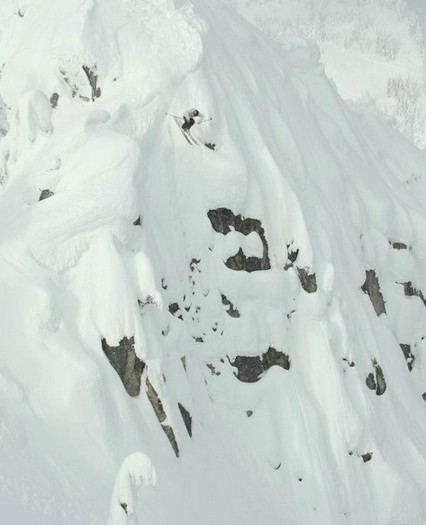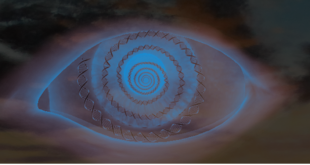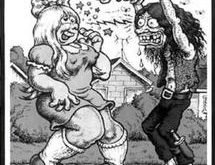Chris, airborne, seconds before injury.
What does it mean to push the envelope? The answer is more complex and charged with light and dark elements than you might think. The phrase originated as an aerospace term as the following entry from Wikipedia makes clear:
This phrase is used to refer to an aircraft being taken to, and perhaps beyond, its designated altitude and speed limits.[4] By extension, this phrase may be used to mean testing other limits, either within aerospace or in other fields.
Pushing the envelope has also become an expression in other fields, referring to the act of introducing new ideas in readily established concepts. An example would be a marketing campaign which advertised its product in a way never done before, or a video game which interacted with the player in a completely original fashion.
It has also been said that one can liken the flying, and especially the testing, of an aircraft to a mail-type envelope, with zero altitude, zero speed, essentially sitting still on the ground, in the lower left corner. As you increase speed and altitude, you move further up and to the right, until you are at the upper right corner, where you are at the limit of what the aircraft can handle. This likeness is particularly apt as this corner is also where a letter gets stamped ‘cancelled’, something test pilots try not to dwell on. http://en.wikipedia.org/wiki/Pushing_the_envelope#.22Pushing_the_envelope.22
The definition of pushing the envelope I have come up with and will employ here is: Boundary expansion into a zone of novelty previously unexplored by the species or an individual.
This essay began as an intention to write a brief oracle card based on the above image, but the topic quickly pushed past that envelope and demanded a more extensive treatment.
Even the image proved to be more complex and ambiguous than I realized. It was at one time the Facebook profile photo of a friend, Chris Catlin. Chris is a twenty-six-year-old EMT-trained ski patroller who was working his fifth season at Steven’s Pass, Washington, when the photo was taken. I knew that he’d recently had his first serious skiing accident, a compound fracture of his leg, but I did not know at first that this accident had any connection to the photo.
One evening I spoke with Chris over the phone, and he unfolded the story behind the image while I took notes. Chris, who had once been a very conservative skier, had for the last year or so been pushing the envelope with his skiing. Brian Shaefer, a professional snowboard photographer, invited Chris to accompany him and some professional snowboarders who were doing a photo-shoot in what Chris called an “out-of-bound zone.” When snowboarders and skiers get themselves photographed doing advanced stunts, and those photos get published in magazines, there is a good chance that they will get valuable sponsorships. Chris admitted that he’d started pushing the ski envelope the previous year when some of his roommates got photos published and thereby gained sponsors.
Somewhere in the out-of-bounds zone, Chris scoped out a feature, a cliff-like drop he had done once before. He recognized that this time there was less soft snow and that his safety margin was even less than his first successful attempt at the drop. Even so, the opportunity seemed too good to pass up. For the last year Chris had been successfully pushing past physical and mental inhibitions to advance his ability to ski in marginal conditions. In his skiing career, he had never had an injury that required even a single stitch.
Chris decided to go for it, while photographer Brian Shaefer was poised on a neighboring peak with his finger on the shutter button. Chris shot off the cliff straight out. He knew that he had to get his body and skis to contour with the transition zone, but despite windmilling his arms he couldn’t get forward enough on his skis, and ended up landing with the full force of a forty-foot drop on the tails of his skis. When he landed, he hip-checked, went into a forward roll, and then was back up on his skis, moving away from the drop, seemingly in control. Incredibly, he didn’t realize anything was wrong until he tried to do a left-hand turn and found that he couldn’t. He stopped skiing and used both hands to pick up his right leg, which he found flopped out beneath him.
To his great embarrassment, Chris had to be rescued from the mountain by his ski patrol colleagues. In addition to the injury and loss of mobility, Chris was out for the season and would lose all the income and adventure that would otherwise have been available to him. Chris didn’t see much of an upside to the experience. In his words, he felt “kicked out of the Garden of Eden.” Working at Steven’s Pass had been literally and figuratively the peak experience of his life. Chris admitted, however, that if the injury hadn’t happened, he would have kept pushing the envelope. Besides the motivation to get sponsorships, he had also become an adrenaline junkie. As Chris put it, “I gave up too much. I didn’t realize what was at stake. I assumed I was good enough not to get hurt. If I hadn’t hurt myself, I would still be out there putting myself into even more marginal situations.” Because of his envelope pushing, Chris now has four titanium screws in his leg and can’t be sure that it will ever be quite as functional as it was before.
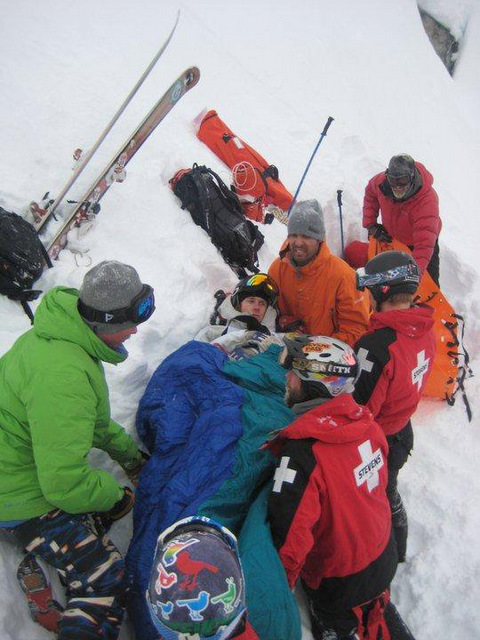
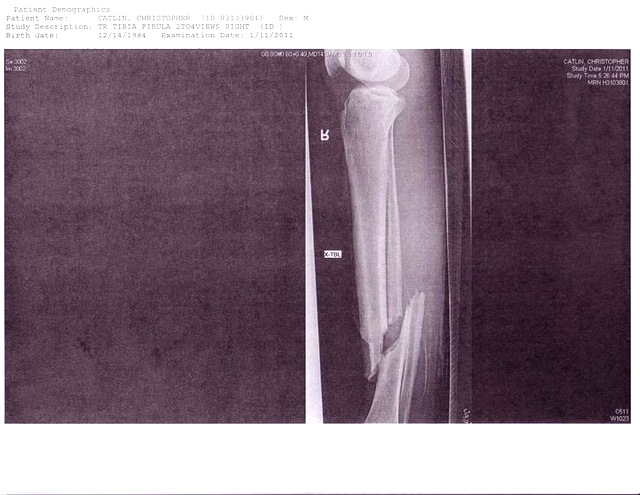

I realize that this is subjective testimony, but based on nine years of knowing Chris and seeing him in a variety of situations—wilderness camping, stressful travel, some hazardous situations, etc.—I have long intuited that he has a protector-warrior essence. I think anyone with an ounce of intuition would at least see the warrior aspect. That Christopher would become an EMT-trained ski patroller, something he has devoted himself to for the last five years, seemed perfectly aligned with what I had already sensed about his essence.
Pushing the envelope with skiing seems in accord with a core aspect of Christopher’s essence, his physical-warrior aspect. It is not surprising that a twenty-six-year-old male with warrior essence will want to test his mettle in an adrenaline-based, kinesthetic, wilderness, male comrade situation. All those elements are archetypally appropriate. When I was twenty-six, I was into mountain climbing, marathon running, and pushing the personal envelope with wilderness and on-the-road adventures with comrades, etc.
There is, however, a one-sidedness to the intensely focused kinesthetic type of pushing the envelope. Except for its body-centric aspects, this mode does not in itself provide much room for the archetypal Feminine. The Feminine could be present, however, through other means. For example, it is likely that this mode of pushing the envelope is pursued in the context of male bonding, with its sometimes mythically strong bonds of affinity between members of an all-male group. Although being part of an all-male group doesn’t sound Feminine, its relational/emotional core is archetypally Feminine.
If this type of pushing the envelope (skiing stunts) were to become an encompassing, all-consuming aspect of Chris’s life, it would probably lead to a high-adrenaline form of stagnation. It would be an exciting but too narrow perch from which to experience life. The physical-warrior aspect would be getting one-sided emphasis in Chris’s life at the extreme cost of other sides of his life. For example, the protector aspect of his essence, which has Feminine and spiritual aspects, would be neglected.
The universe, timeline and mythic drama of an athlete-warrior pursuing excellence and competitive edge in that modality is very qualitatively different from the universe, timeline, and mythic drama of a morally-based warrior putting his life on the line to protect others. The athlete-warrior experiences the dazzling focus you get with single-point concentration on kinesthetic skill and flow. In the best circumstances, the athlete-warrior pierces the envelope like an arrow released from the bow of a master Zen archer. The morally-driven protector-warrior type is less likely to experience dazzling single-pointed focus, but has a more soulful, deep, fulfilling human experience. He pushes a larger envelope, serves transpersonal aims, and is therefore a Warrior with an uppercase “W.” (Except in the previous instance, I won’t use capitalization to distinguish higher and lower forms of the warrior (as I have in my warrior writings). Also, although I’m using the default English pronoun, “he,” throughout the essay, I recognize that being a warrior and pushing the envelope is not the exclusive province of males. In fact, this is a golden age for females to push the envelope.)
Since I’ve attempted to analyze another’s (Chris’s) case of pushing the envelope, perhaps it is only fair that I also analyze my own case, and offer myself up as illustrative example. Of course this is as subjective as it gets, but there is no other case with which I am so intimately acquainted. I find within myself a complex relationship with pushing the envelope, and a number of light, dark, and occasionally ambiguous key aspects and instances. I offer this personal analysis not as autobiography, but as illustration of universal aspects of pushing the envelope.
Even at 53, keeping up a relationship with the physical-warrior seems crucial. As mundane as it might sound, daily workouts can resonate with the physical-warrior. Almost every aspect of my life seems to be intensified and positively influenced when I am trying to push myself during indoor cardio workouts and when I get outdoors and into the weather on my bike, etc. It would be a global diminishment of my quality of life if I were to neglect my daily exercise and instead become an indoor, sedentary, grossly out-of-shape sort of person. Intense, cardio exercise is almost as high a priority in my day as writing. I know that to neglect exercise is also to neglect writing, because I would have less vitality to apply to my writing. Everything we do is a direct function of vitality. When I neglect cardio exercise, I have less vitality the same day. Pushing the envelope with writing requires that I push—or at least maintain— my personal fitness envelope.
My daily exercise is intensified if it includes as many of the following as possible:
That I did intense, cardio exercise where I pushed myself a bit, and continued until healthy exhaustion.
That the exercise also brought me outdoors into the weather and the experience of nature.
Or, alternatively, that I did intense Nordic Track while watching a highly engaging movie, so that the cardio and movie experiences intensified each other.
The exercise I do everyday would be still more exciting if I was likely to break a record, compete successfully in an athletic contest, be photographed for a magazine, etc. I realize that I am unlikely to get a sponsor/photography deal with a magazine looking for pictures of middle-aged guys pushing their heart-rate envelope on a Nordic Track. If it were possible for me to get attention and recognition for athletics, as a narcissistic personality type I would very likely become addicted to that form of high excitement. If that were the case, a great pushing-the-envelope aspect of my life would become an encompassing, one-sided focus that, like Chris’s adrenaline-seeking, would be something less than great. I would push that envelope at the expense of a larger part of my essence that wants to push the envelope in consciousness-related, creative, interpersonal and intrapsychic ways.
After this essay was written, pushing the envelope with cardio exercise has taken on a more literal meaning with new research about high-intensity interval training (HIIT) http://en.wikipedia.org/wiki/High-intensity_interval_training . After decades of doing long slow distance (LSD), I’m now confronted with research that demonstrate significantly more benefit from pushing the heart rate envelope with short all-out bursts. Sean Moffitt, a friend of mine who is a trainer and fitness expert, has been coaching me on this practice for the last couple of weeks. The HIIT workout must be done first thing in the morning because if there is anything in your stomach it will not stay there. I have already seen that it does have a powerful conditioning effect. Physiologically, it is the perfect demonstration of the value of pushing the envelope. The way Sean practices it also demonstrates the will and pain tolerance often involved in pushing the envelope. Even more appropriate, doing a HIIT burst often generates literal tunnel vision. Later, when we explore the downside of pushing the envelope, we will discuss the more figurative tunnel vision it can produce. HIIT also confronts me with an inertial, conservative force in me that doesn’t want to push the envelope this way first thing in the morning. About twice a week it’s worth it to me to overcome that inner resistance and take the HIIT. But I’ve also discovered that even though it is not as efficient or conditioning as HIIT, I’m a lot more enthusiastic about LSD workouts. When your goal is to exercise every day, enthusiasm is invaluable. Five days a week I find that enthusiasm seems to trump pushing the envelope. Pushing the envelope doesn’t work for me in areas that are consistently counter-enthusiastic.
During my present life-phase, pushing the envelope relates to the integration of everything in my day, but feels most present during writing sessions that have involved as many of the following as possible:
That the writing session involved creative breakthroughs.
That the writing session involved the creation of a cultural product that I could share with others and which I feel has moral, human and aesthetic value.
That the writing session also involved a melding of intuition and thinking, allowing me to peer into something and see further into it than I had before.
Ultimately, that the writing session be in the medium of fantasy fiction, so that I am having the peak experience of sub-creation and am an interactive participant in an unfolding, alternate reality.
I want to emphasize this last item, not because of its significance to my particular case, but because it has something to say about a hidden aspect of pushing the envelope that relates to human evolution. But before I can arrive at the evolutionary context, it will be necessary to explore the surprisingly complex social context of this seemingly solitary activity: sub-creative fantasy writing.
Liz Milner, in a review of The Monsters and the Critics in Green Man Review , describes Tolkien’s definition and view of sub-creation:
Sub-creation, he writes, can only happen when fantasy achieves “the inner consistency of reality.” In the most powerful fantastic literature, the author creates a “secondary world.” This is different from a “willing suspension of disbelief,” for the reader must accept that some of the basic “laws” of the secondary world are different from the “laws” of our world. Inside the secondary world, “what he [the author] relates is “true”: it accords with the rules of that world. You therefore believe it, while you are…inside.” Therefore, it is critical that sub-creator apply his rules consistently—otherwise, the reader will be jerked back to this reality. Part of the disdain for fantastic literature comes from the fact that the “secondary world” is so hard to achieve—most fantastic worlds come out half-baked.
[Note: I will sometimes use sub-creation in the Tolkien sense of creating a secondary world, and other times more generally so that it can refer to imaginal worlds that are meant to be set in variations of the primary world.]The sub-creative writing session is an instance of pushing the envelope that I find highly desirable, but only rarely available. This scarcity exists for me because either the muse doesn’t make it available, or there is a more pressing need for me to be available to work on something else. When fantasy fiction writing is happening, however, this form of pushing the envelope feels at least as intense, perhaps more intense, than any other sort of peak experience.
Sub-creative fantasy fiction writing involves pushing the envelope of the Babylon Matrix far enough to merge with alternate, parallel realities. To be able, in some ideal case, to come back from such an instance of participation mystique, sub-creative writing with a cultural product of moral, consciousness-related value, and that it also be aesthetically exemplary such that it will be enthusiastically read, recognized and deeply valued by others, would certainly be ultimate for me. Such an experience is purely hypothetical to me; I don’t know that I’ve ever brought all those elements together. But if I did, that would be about as fulfilling, exciting, engaging and encompassing an instance of pushing the envelope as I can imagine for myself.
An alternate, pinnacle pushing-the-envelope experience for me would be living out (in the outer life) an intense story rather than, or in addition to, sub-creating such a story. As a social mammal, it is not surprising that all my peak, pushing-the-envelope experiences would involve a social context. For example, most of the time when I am writing alone I feel very present in a social context. My peak writing experiences usually involve writing things intended for others. Most get published right away on my website. Sometimes I may have in mind particular significant others that I’m writing for as well as (more vaguely) some larger audience. Knowing that in this era I can write something and then almost instantly make it available to a large proportion of the world’s population, creates an extensive social context. Even if I am exercising in solitude, if I’m honest with myself, I must acknowledge that there is a social/body image layer to the motivation.
Here is another example of what would be a pinnacle, pushing-the-envelope experience for me: I am part of an intense, organic, synergistic fellowship with others and that fellowship experience includes as many of the following as possible:
That it be an hermetic circle where there is an exchange of intuitive insights about both members of the circle and the horizon lines of esoteric knowledge, such that there is creative cross-fertilization amongst psyches.
That the synergy of the hermetic circle, whether we work secretly or publicly, produces deeds, cultural products, larger influences, etc., which are of moral, consciousness-related value to the collective.
That I have bonds to members of the hermetic circle that are heartfelt, soulful, and (problematically, optional) romantic/sexual (wild card, perilous intensifiers).
That the circle is united in a struggle, journey, or endeavor of mythic proportions.
As with the previous example, bringing all those elements together is an idealized fantasy, not an actuality in my life at this time. Both these pinnacle instances of pushing the envelope (sub-creative fantasy writing and hermetic-circle outer-life adventure) have essential elements in common, but are differently proportioned. The sub-creative instance is an inner, alchemical experience that occurs against a misty social backdrop—the sense of a future audience. In the hermetic-circle instance, the synergistic, soulful, creative interpersonal bond is front and center.
The two pinnacle instances I described above (imaginal subcreation /hermetic circle) are related enough that they could easily coincide and have parallel social contexts and motivations. For example, the imaginal sub-creative experience is likely to involve being participant/creator of one or more hermetic circles in the alternate reality.
This may seem exaggerated or unreal to those who haven’t experienced it, but the intense, solitary fantasy sub-creation experience can be potently social. To an outside observer, I might appear to be a middle-aged guy up at an ungodly hour sitting in a chair bathed in the light of a computer monitor listening to Pink Floyd “Echoes” while occasionally typing on a wireless keyboard. To the outside observer, I might look like an obsessed, solitary person in some sort of mesmerized, introverted writing session. Actually, I might be having a powerful, soulful and intense social experience in the imaginal realm.
It’s become almost a cliche for fiction writers to say that their characters took on a life of their own and began to express their separate wills and agendas. Some authors have described characters whose actions seemed other and unpredictable, and sometimes even at cross-purposes to their presumed creator’s conscious intentions. I’ve had experiences with imaginal sub-creation that felt deeply interpersonal—a charged and unpredictable social context. Besides the encounter with what I experienced as autonomous entities, I have also journeyed into alternate realities that were visually, physically and emotionally potent. Many of the most intense and vivid episodes of my life have occurred in the imaginal realm. This is true even though my regular life, whatever other deficiencies it might have, has certainly not been lacking in vivid intensity. So, unless myself and all those other writers are straight-up liars, we must recognize a very significant and distinct type of human experience.
Multiple personality disorder is a very rare condition, but the fact that it occurs at all tells us something about the human envelope. More than one personality/identity can arise in a psyche contained in a single human body. Your psyche has the ability to generate other personalities and whole worlds and timelines. That isn’t hopeful conjecture, it is what you do every night in the dreamtime. Other mammals also dream, but our sub-creative abilities make us the pinnacle of mammals.
The evolution of life on this planet has pushed the envelope inwards, in the direction of greater interiority. The very first thing that the very first cell had to accomplish was some sort of boundary, an ability to enclose interior space for the metabolism of this individual life form to occur without just diffusing into the environment. There is no life without interiority.
From the cellular world, we moved toward cephalization, the tendency for an organism to have an asymmetric concentration of nerve tissue. Cephalization increased as that central nexus of nerve tissue folded itself into a head. When that head grew portals into the exterior world in the form of an array of sensory organs, it began to create an inner simulacrum of the exterior world. A whole new dimension came into being on this planet, the dimension of inner worlds that existed in association with the processing power of ever more complex and differentiated nerve tissue. The complexity and differentiation of nerve tissue, and the complexity and differentiation of inner simulacra have reached their ultimate on this planet, so far, with Homo sapiens.
I’m trying to avoid causal language in how I relate the trends of increased complexity of nerve tissue and inner simulacra because I am not a neurological materialist. I don’t believe it’s as simple as the chicken of greater neurological processing power hatching the egg of ever-larger interior space. For reasons I discuss elsewhere, I believe that these two great processes (increasing neural and inner simulacra complexity) are parallelisms that interpenetrate at certain levels, may have some causal connections, but may also have acausal associations. The alchemical motto says, “As above, so below.” It does not say below causes above, or that above causes below. (See Synchronicity— a Brief Introduction, The Glorified Body, White Crows Rising). And this is why, for example, during an NDE, there can be profound conscious experience while the brain is inactive. (see Life Lessons from the Living Dead for a detailed case history that illustrates this).
I know this will be a controversial claim in some quarters, but I believe that when we push the envelope with imaginal sub-creation, we are at the point of a teleological arrow that shoots through the sometimes-meandering process of evolution. This directional evolutionary force is apparent, furthermore, not just in the phylogenetic evolution of species, but is particularly evident in the very recent history of Homo sapiens. What makes our recent history anomalous, and seems evidence of a distinctly new phase in the parallelism and cross-fertilization of the neural and the sub-creative, is that neurological complexity seems like it is at a relative plateau. The brain of a Renaissance man of today is not anatomically different than that of the Renaissance man of the Renaissance. And yet, the last several hundred years of human culture have seen a steep ramp up in the complexity of inner simulacra, and this is associated with novel developments in cultural technologies and electro-magnetic technologies. For example, the invention and development of the novel was, and continues to be, a powerful manifestation, catalyst, realization and portal into interior space.
No other mammal seems remotely capable of sub-creating such complex and interior artifacts. A novel is an inner simulacrum, that weaves, out of a lattice of words, an unfolding world populated with persons, animals and sometimes other creatures. The wave of novelty represented by the novel, was and is being synergistically enhanced by cultural and technological developments. Novels grew from simple narratives into more complex and interior forms that sometimes include multiple points-of-view interior monologues that are portals into the depths of multiple personalities.
This cultural evolution of sub-creation happened in synergistic association with mechanical technology—the invention and evolution of the printing press— and also electro-magnetic technologies such as movies and television. A movie is almost always a simulacrum of an unfolding world populated with persons, animals and sometime other creatures. At the core of movies is a word-lattice known as a screenplay— the simulacrum within the movie simulacrum that grows from it.
Electro-mechanical technology evolved, and in the present era it has become digital, informational, interactive and globally networked. Consider the incredibly complex simulacra of networked computer games like World of Warcraft. The simulacrum of such a game is not just set in motion by years of collaborative efforts by programmers, computer graphic artists, writers, etc.; it is also the unpredictable performance of millions of networked users. If you had a computer memory capacious enough to store a complete recording of everything that has ever happened in World of Warcraft in the nine years of its existence, you would have a vast density of history. And it would be a history of a dynamic, evolving world, a simulacrum breathed into life by millions of human psyches. And whatever the vast World of Warcraft simulacrum might lack in quality, it certainly impresses with the sheer quantity of it.
Neural, sub-creative and technological evolution are deeply entwined synergistic processes. All are working to merge the physics of the dreamtime with the physics of the waking world. Movies are essentially a dream-delivery technology. Virtual reality realms, like World of Warcraft, bring an experience of dreamtime physics on demand into the waking life.
From this evolutionary perspective, a person having an intense, participation mystique experience sub-creating a novel, or sub-creating an inner movie as they read a novel, would be an example of pushing the evolutionary envelope. Pushing that envelope advances a main drive of evolution—-the expansion of interiority. We’ve gone from the first brain complex enough to support an inner simulacrum of the outside physical world, to psyches that can generate additional personalities and form their own simulacra worlds.
There is another aspect of sub-creation that needs to be included in its evolutionary context. Many authors, artists, composers, etc. will talk about a flow of creativity that seems “channeled.” They will often report that they did not feel like they were doing the writing or painting, etc. but that something was choosing to flow through them. Many great composers have said that they felt they were listening to music that already existed, and they were merely recording the notes.
My own experience is more variable. At times sub-creation feels like a discovery, like I’ve been granted a portal into a world that was already ongoing. At other times what I feel is closer to an enhanced mode of creativity. It isn’t merely my ego/mind doing it. It feels more like something being generated by what Jung called the “Self,” the totality of all the psychic structures. If someone is highly identified with his mind/ego, then the Self can feel other. What I experience may be closer to the feeling that my mind/ego is being enlightened as it channels the Self.
The slippery distinction here is what is meant by “I” when someone says, “I feel like I was channeling it, that I wasn’t the one who was doing it.” If the “I” in the statement is his mind/ego, then it makes perfect sense. Where the distinction gets more slippery is if the “I” is upsized to mean the Self. There is no firewall that separates the Self from even larger fields of intelligence that interpenetrate it—-the collective unconscious, and perhaps a guiding intelligence implicit in the cosmos. Sub-creation may be a manifestation created by a series of overlapping holons. Sub-creation, therefore, pushes the evolutionary envelope because it comes from a realignment of psychic functions and an expansion of the fields of intelligence a human psyche can access.
This powerful expansion parallels in the waking life what is already the case with the dreaming psyche. I have often pointed out that the psyche of a person who does not appear particularly intelligent in the waking life is capable of (apparently) spontaneously generating dreams that could have been directed by David Lynch. The dreams of such people may be filled with triple entendres, multiple layers of meaning, and symbolic, surrealist imagery and situations. The dreams are probably the sub-creations of the Self, but they may also be co-created with some larger field of intelligence, such as the collective unconscious of the species.
When I am involved in sub-creation, I usually experience it as a co-creation. I certainly feel like a participant, and some layers feel like a performance of mind/ego, but I am also aware that the totality of my being, the Self, is involved. Additionally, I sense an active intelligence and will in the medium, the imaginal plane itself, so that it feels like the medium is also shaping its own manifestations. It is fertile to some of my creative impulses, and less fertile to others, so that there is a cross-fertilizing collaboration between sub-creator and medium. This may be another way of saying that the Self is interfacing with a still larger holon. When you are really pushing the envelope into interior space, inner and outer blur.
It’s for you to judge whether I exaggerate the importance of imaginal sub-creation, but I believe it is as essential as dreaming, and is a pinnacle example of pushing the envelope. I have also chosen to emphasize pushing the envelope inward because the extraverted bias of our society tends to emphasize pushing the envelope outwards.
There are many other pinnacle instances of pushing the envelope I haven’t emphasized because they are much better recognized. Science and technology have provided numerous pushing-the-envelope pinnacles, such as splitting the atom, unraveling the human genome, creating mini-black holes in super-colliders, discovering counter-intuitive principles of quantum mechanics, and the ever-weirder theorizing of string theory. These sorts of pinnacles all represent incursions into collective novelty. The list of other pinnacle pushing-the-envelope experiences has increased with the increased metabolism of novelty that our species is undergoing.
Other pinnacle pushing-the-envelope experiences are mostly personal. For example, Joe Simpson is a mountain climber and the author of Touching the Void, an account of his amazing survival story. Simpson narrates the harrowing, sometimes visionary experience of surviving a mountain climbing accident that would be comic understatement to call “life-threatening.” An against-the-odds survival experience like Simpson’s may seem like a purely personal instance of pushing the envelope, but it also has collective aspects as well. It is a pinnacle of mammalian evolution that an injured creature could bring to bear that much situational awareness, intelligence, skill, and sustained will to turn such a no-win scenario around. And of course, his experience also builds on the collective evolution of mountain climbing.
Another type of personal pushing-the-envelope experience is the epiphany, especially one that causes the experiencer to change his life accordingly. If epiphany sounds like a rare and exotic state, consider the following example: An adolescent has an epiphany, a sudden, life-changing discovery: The feelings of other people are real. After he crosses this threshold of perception, his character matures over many decades like a deepening stream. Notice that a personal act of pushing the envelope doesn’t require a remarkable person, or at least not one remarkable by the celebrity standards of the collective. For example, the person pushing the envelope could an elementary school teacher who pushed to the limits of his abilities to become an empathic, impeccable elementary school teacher.
Since we’ve looked at a few of the pinnacles of pushing the envelope, it would be very imbalanced if we didn’t also look into its valleys. I have logged my fair share of time in some of those valleys and write about them from personal experience. Pushing the envelope often means getting caught in the grip of an all-consuming obsession, so that you may become the unconscious hero determined to be the fool that rushes in where angels fear to tread. Pushing the envelope can also make you poor company, and cause you to be absent in relationships because you’re afraid to descend from the high-octane world of pushing the envelope. Let’s say you’re an athlete that is pushing personal and maybe even collective envelopes (in the sense of breaking records). Or let’s say you are a high-power mathematician who has just come up with some breakthrough solution to a key problem in quantum mechanics. It’s going to be very hard to come down from the intensity of that, and enter the slower, often tentative and uncertain rhythms of soulful, interpersonal relations. Some pushing-the-envelope addicts are unable to make that transition. They are like deep-sea divers who have already experienced the bends trying to surface too quickly from the powerful currents of pushing-the-envelope mode into the often-fragile world of human relationships. To extend the metaphor, the deep-sea divers choose to live underwater, pushing the scuba-diving envelope, but at the extreme cost of pushing every other sort of envelope, including incursions into the novelty of soulful human relationships. Bobby Fischer, the chess prodigy, a genius and a world champion, certainly pushed the envelope. He pushed the chess pedal to the metal, but unfortunately this was also at the extreme cost of pushing all other pedals. All of his personal envelopes were in chaotic states of mismanagement and neglect.
An obsessive, monomaniacal, tunnel intelligence in one narrow area inevitably becomes a severe deficit in one or more other areas. My recommendation is to avoid becoming any version of the chain-smoking mad scientist, burning the midnight oil to create something that will shock the world. What is more sustainable is pushing the envelope that engages deep layers of who you are, so that you are not truncating your identity and life to fit into a narrow reality tunnel. However dazzling the focused intensity might be when you push the envelope into a narrow reality tunnel, such single-pointed focus has 350-degree blindness.
To push a larger envelope you need panoramic vision. You need to be able to look all around you to make sure that you are pushing the largest envelope possible for you. If instead, you commit yourself to pushing the envelope into a narrow tunnel, what happens, whether you notice or not, is that significant parts of you get stripped off so that you can fit into such a narrow tunnel.
The story of Mark Zuckerberg and Facebook is a very interesting example of some of the peak and valley aspects of pushing-the-envelope. The example is only helpful if we set up a thought experiment based on a single condition: we replace the real Mark Zuckerberg with the movie character played by Jesse Eisenberg in The Social Network. If the movie character is the example, then any reader who has also seen this movie shares a common data set with the author. Like most readers, I have no special inside scoop on what the real Mark Zuckerberg is like. In the sub-created world of the movie, however, we can be omniscient observers. Once the experiment is over, however, I will point out a couple of things I have heard that suggest pushing the envelope differences between Mark Zuckerberg and the character played by Jesse Eisenberg.
The movie character Mark Zuckerberg (hereafter “Mark”) is an extremely interesting case of pushing the envelope with many classic illustrations of the light and dark sides of pushing the envelope.
One classic element that is almost surreal in both its obviousness and significance is that Mark’s pushing the envelope has a social context. He is driven by certain relationship aims, but those aims are dominated by the power principle. When someone’s social impulse is ruled by the power principle, he will tend to have a ruthless drive to gain social status. This is not some exotic state; it is high school. Striving for social status is the default state not only for human beings, but other primates and social mammals in general.
A National Geographic documentary on primate behavior stated: “Chimpanzees are natural politicians driven by a desire for power.”As primates, we are very concerned with social status, and from a biological point-of-view that concern makes perfect sense. A higher-ranked chimpanzee gains greater access to valuable resources, like food, that increase his chance of survival. The high-ranked male chimpanzee also gains more access to fertile females, which gives him the genetic crown jewel of reproductive advantage. On the other hand, I would guess that higher-ranked chimpanzees are more likely to be involved in violent transactions. The alpha chimpanzee probably takes the lead when there are wars with other chimpanzee troops. Also, strong, young chimpanzees will want to depose him, so he will have to keep fighting to remain the alpha. So even amongst chimpanzees the outcome for gaining status is complex.
Obviously, many of these aspects can easily be mapped onto human examples. A man may achieve a higher social status through success in business, for example, and thereby he captures a trophy wife. Depending on your point of view, this may seem like a very ambiguous form of success. I think the ambiguity comes from an implicit sense that when the human domain parallels the atavistic domain, it is regressive.
If Mark were purely driven by a desire for social status, a desire to show the girl who spurned him what he can do, a desire to become part of certain Harvard Clubs, etc. that would be regressive for his personal evolution. But Mark is not exclusively driven by social aims. While his social intentions are sometimes give more of a voice in the dialogue, Mark is also clearly driven by other forces.
Mark is motivated by the creative muse and a sense of life mission. Mark is aligned with what Aleister Crowley would call his “True Will,” a will that comes from his essence. Mark is determined, at times ruthlessly determined, to fulfill his life mission. His speedy, sharp intellect, his state-of-the-art programming skills, and, yes, his social desires and sense of the social desires of others, all meld perfectly to make him a spearhead of a core intention of the species. As social mammals, if we discover a new power, such as how to make fire, it is a certainty that we will exploit that new power to further our social intentions. For example, we may use fire to cook food that we want to share to enhance a social occasion. Or we may burn women for transgressing a fundamentalist social hierarchy.
Human beings recently discovered a new form of fire, a digital fire, which we are busy using to transform everything. Our world is continually being changed by this new fire, but one thing hasn’t changed that much; we are still social mammals and we are still driven by social intentions. Mark pushes the envelope by bringing the new digital fire together with our intense social intentionality. Combining these fires fulfills a core species intention. Therefore, a significant portion of the species has chosen to join Facebook.
From that point-of-view Mark has achieved an ultimate instance of pushing the envelope. Mark, despite the deficiencies in his personal social life, may have pushed the collective social envelope more than any other person in history. The social context is intense and multi-layered. Mark’s pushing of the envelope, for example, is only possible because of the social context of other computer experts, not just the other programmers working with him on the Facebook code, but also all the other people who collaborated to invent computers, the internet, etc. Mark is at the point of the spear, but millions of other computer folks form the head of that spear, and billions of users form the shaft of the spear.
Of course pushing the envelope, including the species envelope, doesn’t mean there won’t be a dark side to the outcome. Just as Facebook has downsides of distraction and loss of privacy, etc., Mark also confronts many personal valleys in his efforts to push the envelope. He expands social networking but at the extreme cost of his own social life. The girl he loves and his best, perhaps only friend are alienated in the process. The whole Feminine side of his being and experience gets neglected, diminished and corrupted by the Masculine drive to push the envelope.
The actual Mark Zuckerberg (hereafter “MZ”) should not be confused with the movie character. At a party put on by his fraternity in 2003, MZ met his girlfriend, Priscilla Chan, and they have been, more or less together since then. Also, MZ said something, I believe to Charlie Rose, that has implications for pushing the envelope and suggests he has a different proportion of motivations than the movie character. MZ said that what the movie didn’t capture was the sheer joy of getting the code right. It is easier for a movie to dramatize man and woman, for example, than man and software. Although pushing the envelope always has a social context, there is also the joy of when focus narrows to the very edge of the envelope. The awareness of other people may recede entirely when you are at the edge of many envelopes. Although I didn’t ask him about it, I’m sure that when Chris came off the cliff and was trying to come forward on his skis, he had little attention to spare for interpersonal relations.
I began this essay by defining pushing the envelope as: Boundary expansion into a zone of novelty previously unexplored by the species or an individual. That zone of novelty includes both the vastness of outer space, but also the vastness of inner space. As I’ve pointed out elsewhere, when novelty intensifies, the outer edge of light and dark also tend to intensify. When we as a species push the envelope into major new zones of novelty, we must expect light and dark outcomes. For example, once we learned to manipulate the genetic code it was obvious that we would both cure some diseases and also create some horrors. As Sophocles said, “Nothing vast enters the life of mortals without a curse.” Similarly, when we as individuals attempt to push personal and/or collective envelopes we must also be aware of this dual aspect.
 ZapOracle.com home to the free 720-card Zap Oracle
ZapOracle.com home to the free 720-card Zap Oracle

